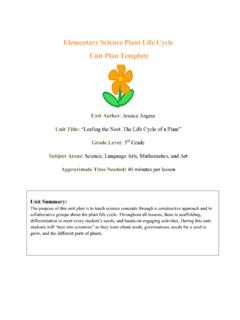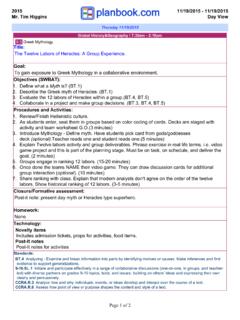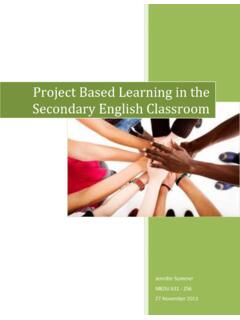Transcription of Lesson Plan #1 Introduction to probability
1 Lesson Plan #1 Introduction to probability grade : 7th grade Subject: Mathematics About the class: - 20 students - 11 boys, 9 girls - 7 students are special education students - One-teach, one-assist format used with special education teacher Standards: Understand that the probability of a chance event is a number between 0 and 1 that expresses the likelihood of the event occurring. Larger numbers indicate greater likelihood. A probability near 0 indicates an unlikely event, a probability around 1/2 indicates an event that is neither unlikely nor likely, and a probability near 1 indicates a likely event. Approximate the probability of a chance event by collecting data on the chance process that produces it and observing its long-run relative frequency, and predict the approximate relative frequency given the probability . For example, when rolling a number cube 600 times, predict that a 3 or 6 would be rolled roughly 200 times, but probably not exactly 200 times.
2 Objectives: o students will identify events that have a probability of chance of 0, , and 1. o students will predict the theoretical probability of a simple event. o students will compute the experimental probability of a simple event. Vocabulary: o Theoretical probability o Experimental probability o probability o Simple Event o Outcome o Complementary Events Orientation/Engagement/Motivation As this is the first Lesson in the unit on probability I will motivate students by using a warm up in the beginning of class that asks them to place six events into a table under the category that best represents its probability of occurring. The category options are extremely likely to happen, 50/50, could happen, and very unlikely to happen. They will then be given the first two minutes of class to place the six events under the appropriate category. As they begin working on this I will tell them that they need to have a reason as to why they chose a particular category for the event because I will ask for reasons as we review the answers.
3 The events they are given are creative and out of the ordinary as will hopefully grab their attention. Later on in the Lesson students will be able to experiment with real world items such as quarters and dice. students tend to enjoy lessons where they get to participate in hands on activities such as this one. As students experiment with these items they will be working with their learning partner. Their learning partner is someone they sit next to that has been chosen as another student who has similar mathematical ability to them. Presentation/Explicit Instruction students will be expected to come into class and get started on the warm up right away as this is part of the daily routine of the classroom. students will come in and complete the warm up. As students are completing the warm up I will circulate the classroom to check their answers. Once everyone is completed or the two minutes are up I will draw their attention to the front board.
4 As a class we will then discuss what category each event should be placed under and why. After all events are correctly placed I will ask students what they think the probability of one of the events in the first column, very likely to happen, is in numerical form. For this I will be looking for the answer of 1 as many students already know that a probability is between 0 and 1. I will do the same thing for the following two categories looking for answers of and 0 respectively. I will then distribute a note packet for the day, which outlines the day s notes, to each student. students will follow along with me on the board filling in missing information throughout the class period. The special education students will receive a packet that already has the vocabulary definitions and examples filled in so they do not have to worry about getting the information down as we talk about it in class. Instead they will be able to follow along with the class and participate as they already have answers or hints to some of the answers of the questions I will ask in class.
5 The first page of the note packet outlines theoretical and experimental probability . I will show the students an interactive coin on the Smartboard and ask the question if I flip this coin, what is the probability it will land on heads? Then I will actually do it as they think about and respond to this answer. I will then lead them through the first few columns of the first row of the chart under quarter. I will explain to them that the favorable outcome is what we want to happen when we flip the coin. After we complete the first three blanks in the probability of getting heads I will have the students complete the rest of the chart with their learning partner and then answer the question that follows about theoretical probability . As students complete this portion of the notes I will circulate the room to be sure everyone is on task and has made no major misconceptions. I will give students three minutes to complete this portion.
6 After the three minutes are up I will bring the class back together and have students explain why the second row of the chart is exactly the same as the first. Then we will create a class definition for why this chart represents theoretical probability . I will then direct students to the second chart on the page labeled dice. For this problem I will again show them an interactive die on the Smartboard to use as a visual. As I begin talking about this chart I will mention to students that we will be actually rolling dice to find probabilities for the events listed at the bottom of the page. I will then demonstrate how they are to perform these rolls. I will roll the die on the Smartboard and under whatever number it lands on I will place a tally mark. I will tell students to continue this pattern until they have rolled the die ten times. Therefore in the end their chart should contain a total of ten tally marks.
7 After they finish rolling their die ten times they are to answer the six probability questions labeled a through f and the question about experimental probability at the bottom of the page. I will give students eight minutes to work with their learning partner to complete this portion of the notes. After the eight minutes are up I will have one group of student share their chart data with me to place on the board. I will tell students that every groups chart will be different and that is ok, but I will put an example on the board and they will have to check theirs using the same ideas to be sure they are correct. We will then develop answers as a class for the data shown on the board. We will talk a little about how some of the answers are related and why that is so. We will also talk about why our denominator for all the probabilities is ten and not six because I foresee many students attempting to place a six as their denominator as there are six sides to a die and if they are following along with the answers to the quarter probability it seems as though this denominator should be the total possible outcomes which is six, however in this case it is not true as we are looking at how many times a particular number appeared throughout our trials or rolls in this case.
8 Finally we will discuss why this was experimental and not theoretical as our quarter chart was. We will then compare our answers to what they should have been theoretically in a perfect world. As a class we will then compile a short list of examples on the board of theoretical and experimental probabilities to reinforce the idea of being either theoretical or experimental. Closure Through completing the first page of the notes students have covered several vocabulary words and actually developed a formula for the probability of an event without even realizing it. Therefore we will close our Lesson by creating definitions for the vocabulary learned throughout the activity which include: probability , simple event, outcome, and complementary events. Complementary events is the only word students will not know from the activity directly therefore that definition will be filled in for them, however they will need to use the probabilities asked about the dice to find an example of two complementary events.
9 For all of the other vocabulary words students should know what they are and be able to develop a definition as well as an example for each. Finally we will close class by developing the formula for the probability of some event using the probability of flipping heads on a quarter as our example to derive this formula. At the end of class I will alert students to the last page of the notes telling them that this page will be their homework for the night. I will explain to them that the first three problems represent theoretical probability and the fourth problem actually asks them to experiment with something. Assessment For this Lesson informal observations of students will be used as their assessment. students are given several opportunities, including while completing the warm-up, the quarter chart, and the dice chart, to work with their learning partners to learn about theoretical and experimental probability as well as simple events and outcomes.
10 During this time I am given several opportunities to circulate the classroom in order to observe how well students understand the material. This is beneficial as it allows me to work with students who are noticeably struggling with the material as some students who often excel will struggle with this topic as those who often have difficulty in math will excel as this is just that kind of topic. As I observe my students I will be looking especially closely at their responses as to why something is either theoretical or experimental taking a mental note of which students have very good, thoughtful, detailed answers so I know who I can call on if the class seems to be at a standstill as we review the material. Throughout all informal observations of students I will be looking to see if they understand what kind of an event is very likely, 50/50, or very unlikely, as well as if they understand how to find the probability of a simple event.





